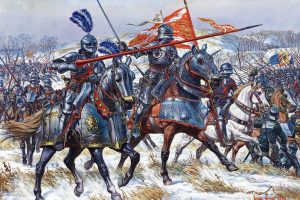Burgundy, a region of France, was first a kingdom after the collapse of the Roman Empire, roughly speaking the fifth century. It was incorporated into the Carolingian Empire, divided by the Treaty of Verdun, and finally combined with the Kingdom of Provence in the tenth century.
Dukes of Burgundy, though sometimes richer than kings of France, and owning more land, towns, hamlets and troops, were in fact officially vassals, as indeed was the King of England. Even Henry II Plantagenet paid hommage to the French king; Burgundy was the greates of these vassals. Many dukes tried to gain independence from the royal family, and were prepared to go to any lengths to achieve their purpose. No French king, however wealthy or in need of finance, was able to trust a Duke of Burgundy.
A good example of their inbred treachery was the so-called Hundred Years War (q.v., 1337 – ) in which Burgundy chose to take the side of the English. Charles the Bold, Duke of Burgundy from 1467 – 77, also sided with the English king. He was a valuable ally too, as dynastic marriages had been effected which united Burgundy with Flanders, bringing the immense wealth of the Netherlands to fill the coffers of the duke. France, however, managed to keep hold of Champagne, thus separating the two parts of the ducal territory. When Charles the Bold was killed in battle in 1477, all Burgundy was retained again by the French crown.
The House of Burgundy arose from the French royal Capet dynasty, through another bold duke – Philip, 4th son of King John 11 (‘the Good’) of France. Philip became the first Duke in 1363. The family possessed really vast territory in both Burgundy itself (almost a fifth of France) and in the Low Countries. Successive dukes maintained expansionist policies throughout the fifteenth and early sixteenth centuries. But, matters being how they were in the medieval epoch, with the death of Charles the Bold (detailed above) in 1477, Burgundian possessions passed by marriage to the Imperial House of Austria – the Habsburgs (q.v.).
New leaders therefore continued the expansionist policies of previous dukes in the Low Countries, signifying today’s Belgium, the Netherlands and a goodly slice of northern France. During the fifteenth century the court of the House of Burgundy was seen as one of the major cultural centres of Europe, competing with England and France in matters of chivalry (jousts, armour-making, fine clothing and a gentlemanly manner) and as patrons of the arts.









Leave A Comment